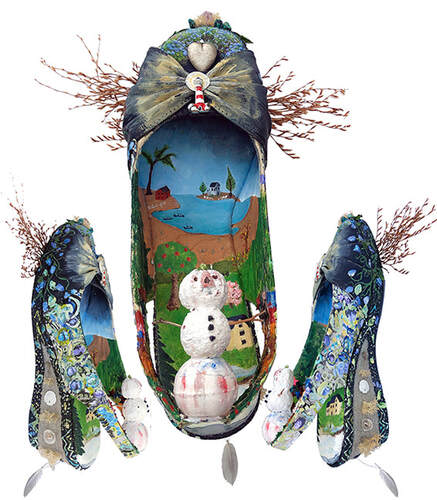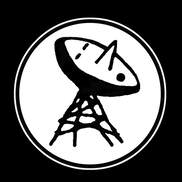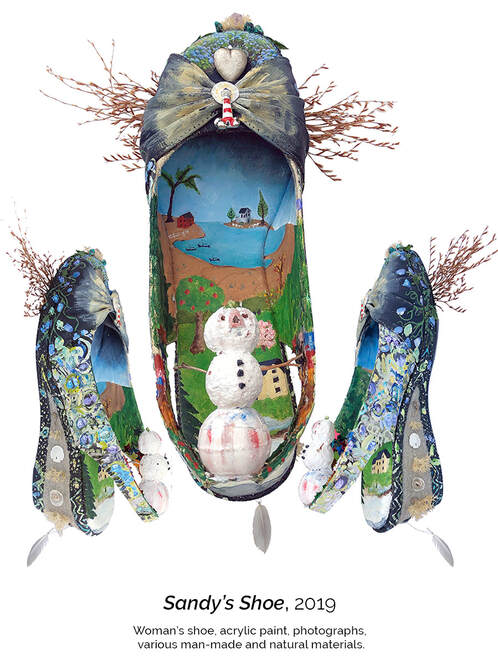 This shoe portrait is an homage to my late cousin Sandra Kehoe. She was a luminous person, significant partner and wife to Dan, and amazing mother to her three boys, Brian, Paul and Scott, and grandmother to Scott's children. Sandy was my mom’s favorite niece and was close to her right up until the end of Sandy’s life. She was a beautiful soul and I felt compelled to create a portrait as part of my shoe series. To do this I began with her sons who helped select a shoe that best represented their mom. I wanted to represent her life, her interests and her being. I will describe the process by areas of the shoe. Exterior The color scheme was based on Sandy’s love of hydrangeas from which I chose violet, blues and greens. The left side of the shoe was a collage of Sandy as mom to three amazing boys and represents a continuum across her life from little children to grown adult men. The right side of the shoe is a collage of images from her infancy through teens to marriage and retirement. In the top most part of the shoe is a small collection of crystals representing her and her children. In the toe section of the shoe is a locket on top of photographs of her hydrangeas. Inside the locket are two images: a photo from her nurses’ graduation and a cut silhouette that was made when she was a child. At the strap across the shoe in the center is a lighthouse. This symbol not only represents my view of her spirit as a beacon of light but it is a motif that shows up in many of her folk art paintings. She loved the ocean and all things associated with it. Which is why the two ‘wings’ that extend from the ends of the lighthouse beacons are represented with beach heather…a material that she loved to decorate with which her son Paul and I would collect when we kayaked along the shore in Eastham on Cape Cod. Interior Sandy loved to paint in a folk art style inspired by the work of Warren Kimble. For the interior, I made photographs of all of Sandy’s work and I synthesized a composition using many of the elements from her paintings. Hidden underneath the strap I glued a very small starfish as a second representation of her spirit. In the lower section, cradled in the strap is a snowman, another one of Sandy’s favorite motifs (she would display over 100 of them during the winter holidays.) She loved decorating for the holidays, early on for her boys and then later for her grandchildren. The most extensive displays were created for Halloween, Christmas and the Fourth of July, so I incorporated all of those themes into my ‘snowman’. Lower Shoe On the exterior is beach sand and natural elements representing her love of the sea. On the very bottom is the third and final representation of Sandra’s spirit…a feather, which still dances around as the air around it sees fit. Please check out more new work here.
0 Comments
As an artist whose primary medium is assemblage, I thought I would share what I’ve come to learn about its nature and origins.
What is assemblage? Assemblage is a relatively modern art form which emerged in the early 1900’s. Its unique attributes differentiate it from other mediums. _ It is a 3 dimensional artwork that is assembled rather than painted, drawn, modeled or carved. _ Its elements are entirely, or in part, natural or manufactured materials, objects, and fragments which were not intended as art materials. _ Assemblage originates in unrelated fragments thereby forcing the materials to exist on several planes. The method of assemblage is one of juxtaposition: setting one thing beside another without previous connection. Incongruous elements can be transformed into a new ensemble revealing a power in the objects previously unseen. In this process the artist serves as both the originator and the discoverer. In its structure assemblage is like abstract painting and constructivist sculpture although it diverges from these traditions in two key ways. First, its raw elements already have existing associations that are identifiable to us be they photographs, twigs, doll parts, rusted automobile parts, old letters, etc. Secondly, the new configurations are inherently not predetermined so they are open to assume new meanings. The Antecedents of Assemblage Collage There are examples of artists attaching objects to paintings in the 1800’s but Collage has been a formally recognized medium since the early 1900’s, appearing during Cubism and growing through DaDa and Surrealism. DaDa awakened senses and sensibilities to the immense multiple collisions of values, forms and effects among which we live. Dada affirmed the principle proposed by the futurists that art could be created by any elements whatsoever including materials previously looked down upon or ignored. Collage involves three aspects: _The challenge of representing or organizing a surface with unrelated materials. _It embodies the concept of unforeseen relationships, those discoveries brought about through new associations which forces the materials to exist on several planes in many various meanings. _Artistic pleasure in making things and interacting with materials. The conventional use and practices of traditional art materials had limited these kind of exploratory interactions. Art of the Untrained I have developed a deep appreciation for artworks made by individuals without formal artistic training. This genre of art has been labeled as Outsider Art and includes work made by children, visionaries, the mentally ill, and folk artists as well as just regular folks. These ‘outsiders’ show unusual and powerful resourcefulness in their use of common and uncharacteristic materials. The works also convey the strong need to create. Some noteworthy examples: During the Victorian era human hair was arranged in shadow boxes. Hair art was often created in group settings to bring structure to mourning which resulted in a very tangible way of remembering a loved one. Hair wreaths were also made to commemorate the living using the hair of family members. Also during this time period Sailors Valentines were brought home to loved ones as a memento of a sailor’s voyage at sea. These elaborate shell creations were not made by the sailors but were often produced on the island of Barbados. Memory Jugs or Memory Jars were personal memorials whose surface was covered with shards of china, glass, mirror, shells, beads, buttons, coins,toys other small objects associated with the dead person. They were popular in the late 19th early 20thcentury. In the summer of 1945 the artist Jean Dubuffet was prospecting for marginal works of art that were derived from the individual artists own sources and impulses without regard to rules. He called this collection Art Brut, or raw art. He sought out marginal, self-trained creators of independence and inventiveness. Often these works reflected acute mental states, elaborate worlds of fantasy or unconventional ideas but all outside the boundaries of official culture. This important collection, Collection de ‘Art Brut, is housed in a museum in Lausanne, Switzerland. Was 1912 the Birth of Assemblage? It is reported that in 1899 the painter Antonio Mancini exhibited a canvas in Venice in which metallic keys from a clarinet were embedded in a painted representation of it. He also embedded bits of glass, tinfoil, and other foreign substances to create rich textural effects on the paint surface,however, most sources I have come across give Picasso credit for the invention of assemblage. I recently came across a very interesting publication from the Picasso estate. It discusses the Futurist Manifesto penned by the artist Umberto Boccioni. In it he calls for sculpture to use a plurality of materials “transparent planes, glass, celluloid, sheets of metal, wire, external or internal electrical lights”…and the use of color to “increase the emotive force of the planes.” In 1913 Boccioni exhibited a work where he inserted real objects like a window, wig, glass eye, piece of railing into a mass of plaster that he textured, added color and inscribed words. This pivotal piece, “Fusion of Head and a Window, 1912” was photographed but the piece ended up being destroyed. It appears that Picasso was directly impacted by the show as new elements appeared soon after in his own sculptures. Conversely Picasso’s cubist Head of a Woman had considerable impact on Boccioni. However, it really does seem that Boccioni was the person responsible for moving art-making towards the objective of fusing the object with its environment. My Path to Assemblage Photography was my preferred medium for many years but with occasional side experiments in collage, (some of which found their way into a 1982 exhibition at MIT titled Dadakin: Recent Works by Boston-Area Artists in the Spirit of Dada). As a fine art photographer I worked in the tradition of social documentarians Brasaii, Walker Evans, and Lee Friedlander. I explored how we interact with the land, our animals, and each other. Following my exhibition American Wastelands in 1992, and work being published in the periodical Aperture (Issue #120, Beyond Wilderness), I put my camera down. I had become increasingly dissatisfied with the limitations of the medium. By its nature a camera records the reflected world in precise detail and in fractions of a second. Realistic detail had become my limitation. Also recent experiences affirmed my emerging awareness of a powerful and paramount inner reality which photography could not easily or accurately express. My emotions, intuition, and intellect needed a new way to explore and communicate. The seeds were planted for new expressive growth upon visiting the Joseph Cornell retrospective at the MOMA in 1980. The work was so unique and compelling. I was struck by the way he constructed small worlds of mystery and intrigue with everyday materials. The real turning point came, however, in 1996 with the massive retrospective of Ed and Nancy Kienholz at the Whitney Museum of Art. The path forward now became much clearer. I saw the distinct possibilities of taking the scraps and bits and pieces of the world and using my hands to form my own vision and perhaps evoke deeper realities than exterior appearances conveyed. Over the years I have studied and learned from other others that have not been bound by conventions or the strict use of materials, among them Robert Rauschenberg, Alberto Burri, and Anselm Kiefer. |
Details
Author An interdisciplinary artist writing on art and art making. Archives
May 2021
Categories |

